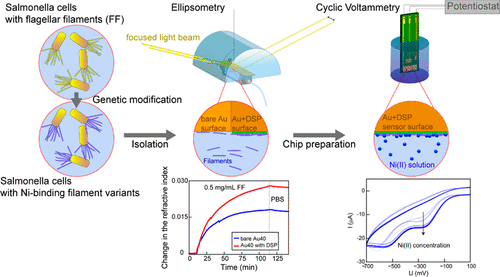当前位置:
X-MOL 学术
›
ACS Biomater. Sci. Eng.
›
论文详情
Our official English website, www.x-mol.net, welcomes your
feedback! (Note: you will need to create a separate account there.)
Sensing Layer for Ni Detection in Water Created by Immobilization of Bioengineered Flagellar Nanotubes on Gold Surfaces
ACS Biomaterials Science & Engineering ( IF 5.4 ) Pub Date : 2020-05-21 , DOI: 10.1021/acsbiomaterials.0c00280 Zoltan Labadi 1 , Benjamin Kalas 1 , Andras Saftics 1 , Levente Illes 1 , Hajnalka Jankovics 2 , Éva Bereczk-Tompa 2 , Anett Sebestyén 2 , Éva Tóth 2 , Balázs Kakasi 2 , Carmen Moldovan 3 , Bogdan Firtat 3 , Mariuca Gartner 4 , Marin Gheorghe 5 , Ferenc Vonderviszt 1, 2 , Miklos Fried 1, 6 , Peter Petrik 1
ACS Biomaterials Science & Engineering ( IF 5.4 ) Pub Date : 2020-05-21 , DOI: 10.1021/acsbiomaterials.0c00280 Zoltan Labadi 1 , Benjamin Kalas 1 , Andras Saftics 1 , Levente Illes 1 , Hajnalka Jankovics 2 , Éva Bereczk-Tompa 2 , Anett Sebestyén 2 , Éva Tóth 2 , Balázs Kakasi 2 , Carmen Moldovan 3 , Bogdan Firtat 3 , Mariuca Gartner 4 , Marin Gheorghe 5 , Ferenc Vonderviszt 1, 2 , Miklos Fried 1, 6 , Peter Petrik 1
Affiliation

|
The environmental monitoring of Ni is targeted at a threshold limit value of 0.34 μM, as set by the World Health Organization. This sensitivity target can usually only be met by time-consuming and expensive laboratory measurements. There is a need for inexpensive, field-applicable methods, even if they are only used for signaling the necessity of a more accurate laboratory investigation. In this work, bioengineered, protein-based sensing layers were developed for Ni detection in water. Two bacterial Ni-binding flagellin variants were fabricated using genetic engineering, and their applicability as Ni-sensitive biochip coatings was tested. Nanotubes of mutant flagellins were built by in vitro polymerization. A large surface density of the nanotubes on the sensor surface was achieved by covalent immobilization chemistry based on a dithiobis(succimidyl propionate) cross-linking method. The formation and density of the sensing layer was monitored and verified by spectroscopic ellipsometry and atomic force microscopy. Cyclic voltammetry (CV) measurements revealed a Ni sensitivity below 1 μM. It was also shown that, even after two months of storage, the used sensors can be regenerated and reused by rinsing in a 10 mM solution of ethylenediaminetetraacetic acid at room temperature.
中文翻译:

生物工程鞭毛纳米管固定在金表面上产生的水中镍检测的传感层
Ni的环境监测的目标是世界卫生组织设定的0.34μM阈值限值。通常仅通过耗时且昂贵的实验室测量才能达到此灵敏度目标。即使是仅用于表示必须进行更准确的实验室研究的信号,也需要廉价,可现场应用的方法。在这项工作中,开发了生物工程,基于蛋白质的传感层,用于水中镍的检测。使用基因工程技术制备了两种细菌结合镍的鞭毛蛋白变体,并测试了它们作为镍敏感生物芯片涂层的适用性。通过体外构建突变鞭毛蛋白的纳米管聚合。通过基于二硫代双(丙酸琥珀酰亚胺酯)交联法的共价固定化化学方法,可实现传感器表面纳米管的大表面密度。感测层的形成和密度通过光谱椭圆偏振法和原子力显微镜进行监测和验证。循环伏安法(CV)测量显示Ni灵敏度低于1μM。还表明,即使在储存两个月后,也可以通过在室温下在10 mM的乙二胺四乙酸溶液中冲洗来再生和重新使用用过的传感器。
更新日期:2020-07-13
中文翻译:

生物工程鞭毛纳米管固定在金表面上产生的水中镍检测的传感层
Ni的环境监测的目标是世界卫生组织设定的0.34μM阈值限值。通常仅通过耗时且昂贵的实验室测量才能达到此灵敏度目标。即使是仅用于表示必须进行更准确的实验室研究的信号,也需要廉价,可现场应用的方法。在这项工作中,开发了生物工程,基于蛋白质的传感层,用于水中镍的检测。使用基因工程技术制备了两种细菌结合镍的鞭毛蛋白变体,并测试了它们作为镍敏感生物芯片涂层的适用性。通过体外构建突变鞭毛蛋白的纳米管聚合。通过基于二硫代双(丙酸琥珀酰亚胺酯)交联法的共价固定化化学方法,可实现传感器表面纳米管的大表面密度。感测层的形成和密度通过光谱椭圆偏振法和原子力显微镜进行监测和验证。循环伏安法(CV)测量显示Ni灵敏度低于1μM。还表明,即使在储存两个月后,也可以通过在室温下在10 mM的乙二胺四乙酸溶液中冲洗来再生和重新使用用过的传感器。











































 京公网安备 11010802027423号
京公网安备 11010802027423号